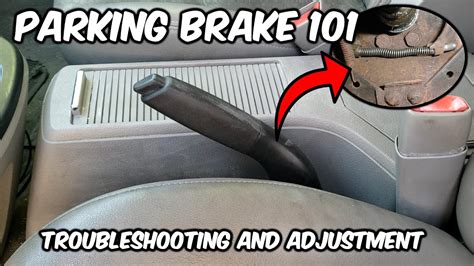Parking Brake Troubleshooting & Adjustment: A Comprehensive Guide
Your parking brake, also known as the emergency brake or handbrake, is a crucial safety feature. A malfunctioning parking brake can lead to dangerous situations, so understanding how to troubleshoot and adjust it is vital for any vehicle owner. This guide provides a comprehensive overview of common parking brake problems and how to address them. We'll cover everything from simple adjustments to more complex repairs, empowering you to diagnose and potentially fix the issue yourself, or at least effectively communicate the problem to a mechanic.
How Does a Parking Brake Work?
Before diving into troubleshooting, it's helpful to understand the basics. Most modern vehicles utilize a drum-type parking brake system, integrated within the rear brake assemblies. Some vehicles, especially older models, may employ cable-actuated systems operating on the rear wheels directly. Regardless of the type, the system relies on a lever (handbrake) or pedal (foot-operated parking brake) to engage a mechanism that clamps down on the rear wheels, preventing them from rolling. This clamping action is achieved through mechanical linkages, cables, and brake shoes or calipers.
Common Parking Brake Problems
Several issues can cause your parking brake to malfunction. Let's examine some of the most frequent problems:
1. Parking Brake Doesn't Hold:
This is the most common complaint. The vehicle rolls even when the parking brake is fully engaged. Several factors could be at play:
- Weak or Worn Cables: Over time, parking brake cables can stretch or corrode, reducing their effectiveness. This is particularly common in areas with harsh winters and road salt.
- Adjustments Needed: The parking brake mechanism might need adjustment. The brake shoes or calipers might not be engaging sufficiently.
- Internal Brake Problems: Issues within the rear drum brakes or rear disc brakes themselves (e.g., worn brake shoes/pads, damaged drums/rotors) can impact parking brake performance.
- Contaminated Brake Parts: Grease, oil, or other contaminants on the brake shoes or drums can prevent proper engagement.
2. Parking Brake Feels Loose or Doesn't Engage Fully:
This often indicates a problem with the cable adjustment or a mechanical linkage issue. It might feel like you need to pull the lever excessively to achieve adequate braking.
3. Parking Brake is Difficult to Release:
This usually points to a problem within the release mechanism or a cable binding issue. Sometimes, this is due to corrosion within the cable housing.
4. Parking Brake Makes Noise:
Grinding, squealing, or clicking sounds when engaging or disengaging the parking brake are common signs of wear and tear, possibly indicating worn brake shoes, a damaged cable, or issues with the mechanism itself.
How to Troubleshoot Your Parking Brake
Troubleshooting your parking brake involves a systematic approach:
1. Check the Parking Brake Lever/Pedal:
Ensure the parking brake lever or pedal engages fully. A partially engaged brake will obviously not hold the vehicle.
2. Inspect the Cables:
Carefully examine the parking brake cables for any signs of damage, corrosion, or fraying. Look for any points where the cable might be kinked or rubbing against other components.
3. Check for Brake Adjustment:
The adjustment procedure varies depending on the vehicle's make and model. Consult your owner's manual for specific instructions. Generally, it involves adjusting a cable or a ratchet mechanism to tighten the brake shoes or calipers.
4. Inspect the Rear Brakes:
If the cables and adjustment seem fine, the problem might lie within the rear brakes themselves. This requires a more in-depth inspection, often best left to a professional mechanic.
How to Adjust Your Parking Brake (General Guidelines – Consult your Owner's Manual!)
The exact adjustment method varies greatly between vehicles. Always consult your owner's manual for the specific procedure for your car. Improper adjustment can damage your brake system. However, general principles often involve:
- Locating the adjustment mechanism: This is usually located near the rear brake calipers or drums.
- Accessing the adjustment: This often requires removing wheel covers or wheels.
- Adjusting the cable: A turnbuckle or ratchet mechanism allows for cable tension adjustment. Tighten until the parking brake holds effectively but releases smoothly.
- Testing the adjustment: After adjusting, test the parking brake on a slight incline to ensure it holds the vehicle securely.
When to See a Mechanic
If you're uncomfortable performing any repairs yourself, or if the problem persists after attempting adjustments, it's best to take your vehicle to a qualified mechanic. They have the tools and expertise to diagnose and repair more complex parking brake issues. Ignoring a faulty parking brake can be extremely dangerous, so addressing the problem promptly is crucial.
This comprehensive guide provides a solid foundation for understanding parking brake troubleshooting and adjustment. Remember to always prioritize safety and consult your owner's manual for vehicle-specific instructions. By understanding the potential problems and troubleshooting steps, you can maintain the crucial safety feature that is your parking brake.

